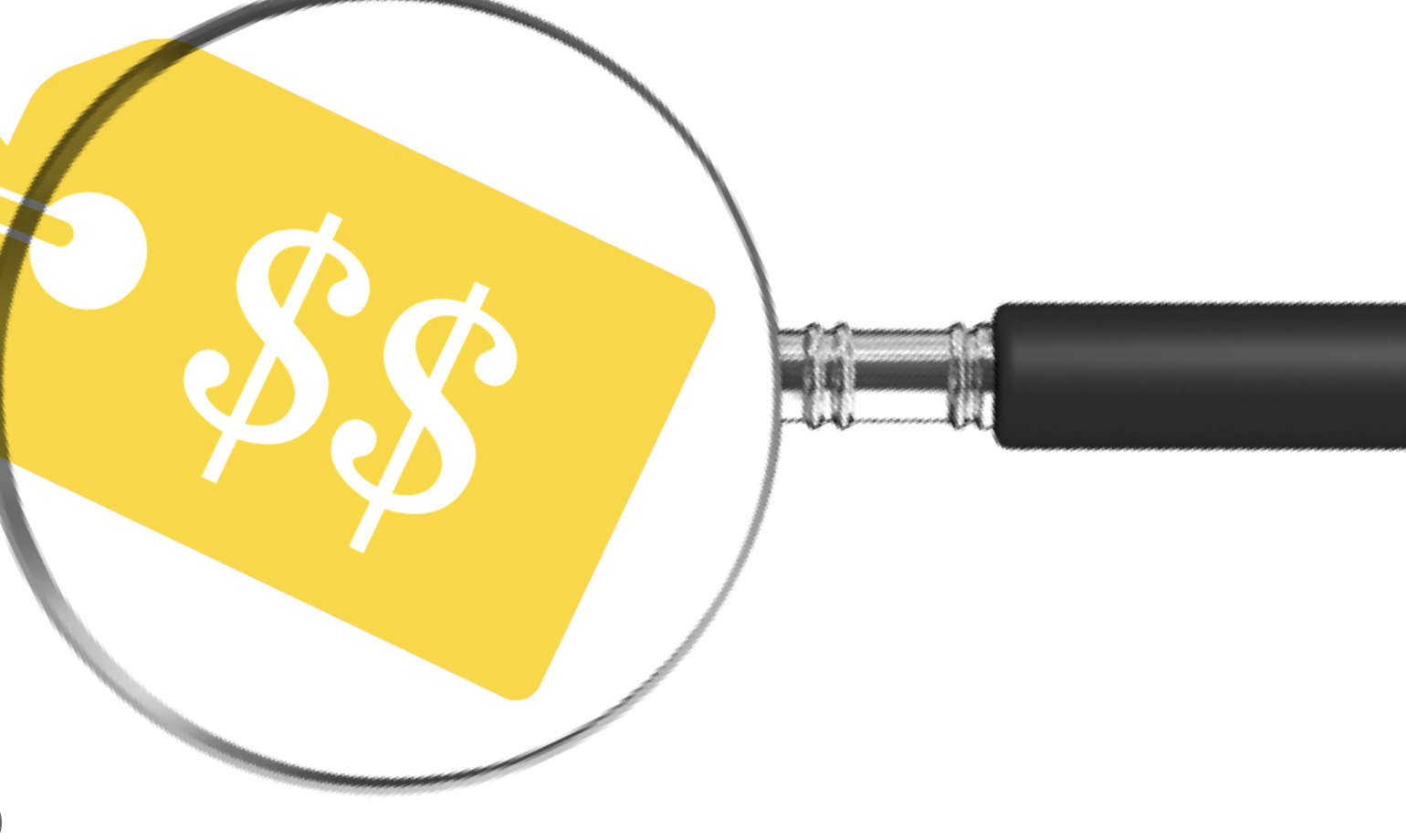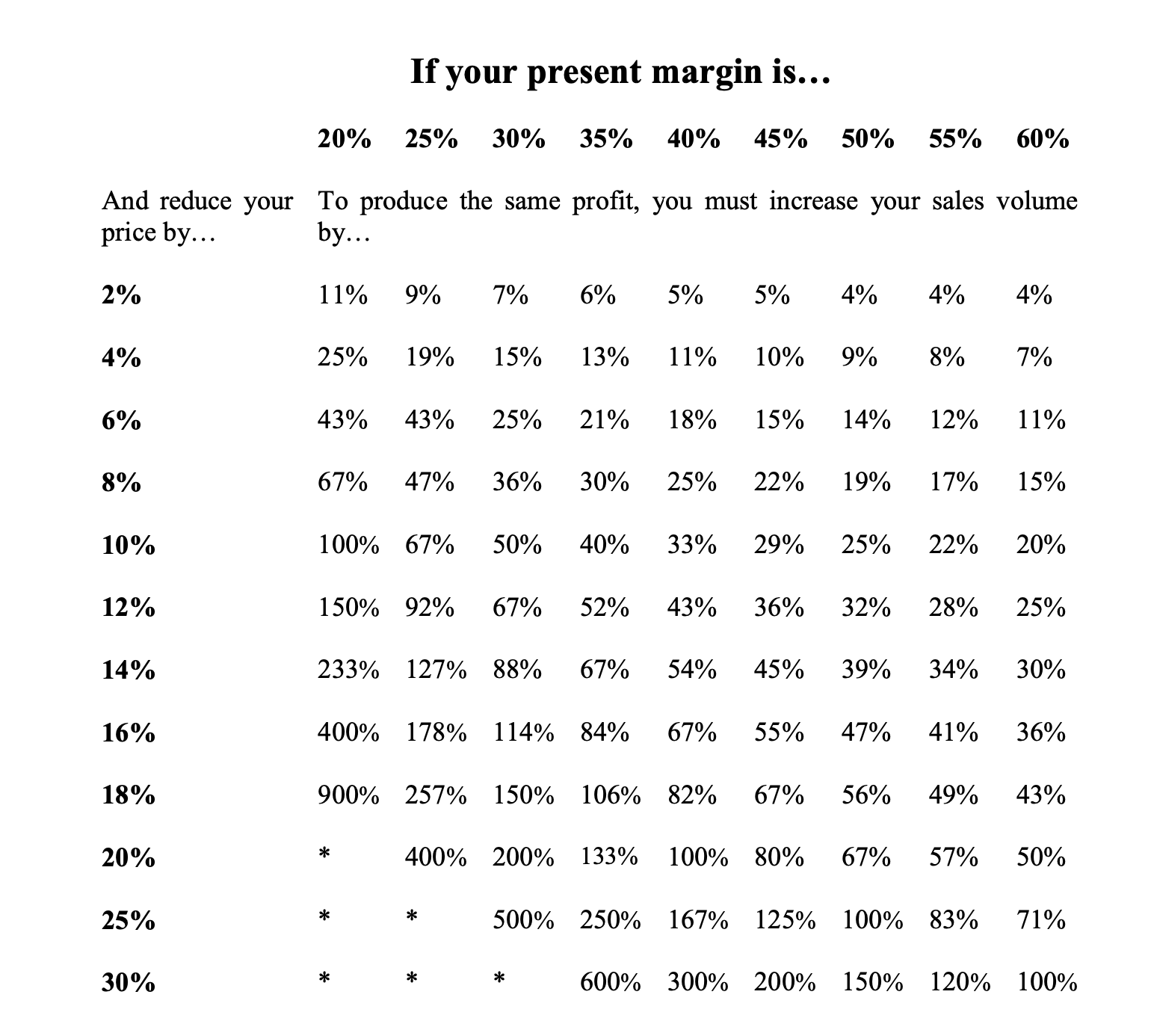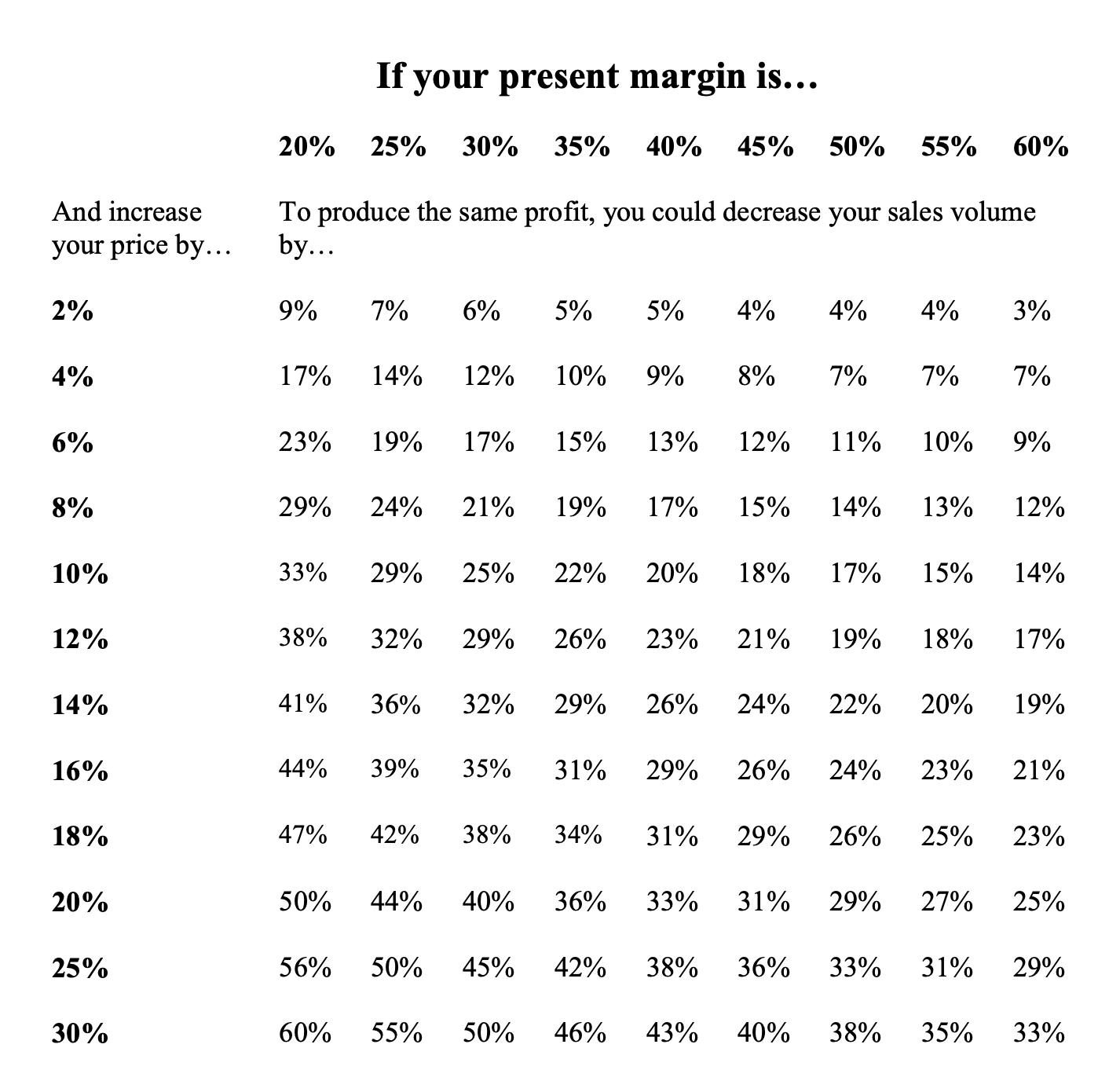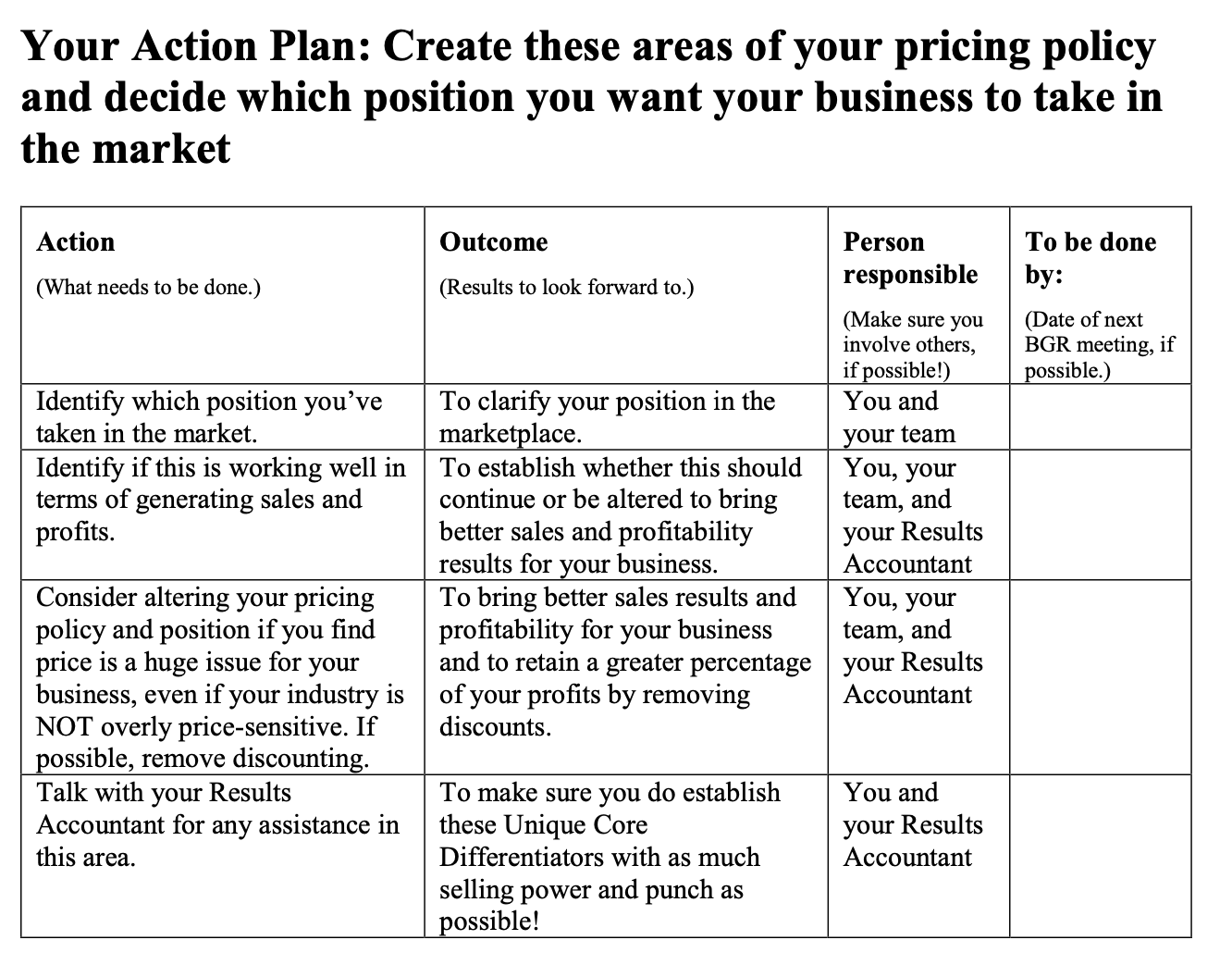Your Pricing Strategy – The Power of Positioning
 This information is designed to give you insight into why it is important to decide where you want to be positioned in your market. This
positioning happens through your pricing policy.
This information is designed to give you insight into why it is important to decide where you want to be positioned in your market. This
positioning happens through your pricing policy.
You’ll find out what establishing pricing policy involves for your business and what it could mean to your future.
Your pricing policy options
When it comes to price, it’s important to position yourself in the market. To do that, you have several options. These options are created by the critical mix of your profit margins and your desired sales volumes.
1. Low margin / high volume

This places your products or services at the cheaper end of the market. Yours might be considered a ‘budget’ purchase within your market.
Bargain basement clothing or variety superstores tend to operate on this premise. For example, department stores offering 20% off all prices on a certain day of the year or on a certain range of products are working on this premise. By dropping the margin, their target market—bargain shoppers—come running and buy big! This means that the company still makes a healthy profit based on the volume sold rather than the margins themselves.
2. High margin / low volume

Here, your products and services have a high margin with a low volume of sales. Obviously, the reverse is true in this case. This means the company still makes a healthy profit based on the margin rather than the volume itself. The high margin compensates the business for the low volume.
This places your products or services at the more expensive or upmarket end of the scale and will appeal to non-price-conscious buyers, of which there are many.
3. Low margin / low volume
This is not something you want to choose for your business! This means that your products and services are not overly profitable. AND that you don’t sell a high volume either! This option is to be avoided as your business will not grow easily or be profitable.
4. High margin / high volume
And finally, the ideal option. In this case, you get the best of both worlds—high margins and a high-demand products that sell in high volume. What could be better?
Options 1, 2, and 4 have merits based on your business, your products and services, and your desired position in the marketplace.
To discount or not to discount
Pricing policy also means establishing your discounting policy. In short—don’t do it!
For the most part, avoid discounting at all costs.
Be strongly advised that discounting will eventually eat away at your profits and will NOT, repeat NOT, generate a significant return in sales to your business.
Without doubt, the biggest single barrier preventing small business managers from making an acceptable profit is a refusal to charge a price or stop discounting to allow a true profit. An undiluted profit. A deserved profit.
At this point, it’s really important to remember that you aren’t in business to match the price your competitors set. You are here to serve your customers well.
In fact, studies of the factors people regard as important influences on their decision to deal with a particular business indicate that product and price influence only 15% of the cases!
Price discounting influences only one situation—where you have a definite cost advantage (either variable or fixed) over your competitors and your product or service is one where customers are genuinely, truly, price-sensitive.
Consider the next tables. The first puts a strong case forward for NOT discounting. The second asks you to consider actually increasing your prices instead. Now there’s a thought!
The following table indicates the increase in sales required to compensate for a price discounting policy. For example, if your gross margin is 30% and you reduce price by 10%, sales need to increase by 50% to maintain your initial profit. Rarely has such a strategy worked in the past, and it’s unlikely that it will work in the future.

Interestingly, discounting doesn’t generate a great response from customers. This is true for several reasons. They think, ‘What’s wrong with it? If it’s so good, why can’t you sell it? Why do you have to discount it so much?’
These days, people are understanding more and more the concept of ‘you get what you pay for’ or ‘there’s no such thing as a free lunch.’ Many customers h e lear ed a hard lesson by buying cheap products or services that don’t live up to expectations. A lesson that’s to your advantage. Most people understand that a fair exchange has to be made to win a fair product or service.
A man named John Ruskin once said this:
It’s unwise to pay too much, but it’s worse to pay too little. When you pay too much, you lose a little money, that’s all. When you pay too little, you sometimes lose everything, because the thing you bought was incapable of doing the thing it was bought to do. The common law of business balance prohibits paying a little and getting a lot—it can’t be done. If you deal with the lowest bidder, it is well to add something for the risk you run, and if you do that you will have enough to pay for something better.
People are starting to be more careful in purchasing heavily discounted products.
 In addition, many people find it difficult to calculate discounts in their head. As such, discounts often fail to hold much significance to
your potential customers in the buying process. This lack of interest is particularly true if the customer is as yet unaware of the price of
the products or services on offer. This can occur where businesses go ahead and promote discounts without the price attached!
In addition, many people find it difficult to calculate discounts in their head. As such, discounts often fail to hold much significance to
your potential customers in the buying process. This lack of interest is particularly true if the customer is as yet unaware of the price of
the products or services on offer. This can occur where businesses go ahead and promote discounts without the price attached!
Remember, too, that most times customers only shop on price because it’s how they’ve been trained by businesses to find what they want.
From a marketing point of view, it would be better to fix a dollar value to your offer to attract customers. Better yet, avoid it completely! Customers are far more attracted to added-value items, packages, education, free reports, or services that mean they can achieve more from your product or service than they would have before.
The next table shows the amount by which your sales would have to decline following a price increase before your gross profit is reduced below its previous level. At a 30% margin and a 10% increase in price, you could sustain a 25% reduction in sales volume before your profit is reduced to the previous level—you would have to lose 1 out of every 4 customers!

Often, sales can actually increase as prices increase. Particularly when
of a consistently high quality, each team member takes a genuine interest in the clients’ needs, and clients are kept up-to-date about
information and new products. After all this, the price is often almost unimportant.
Those many small business people who regard price as the only factor influencing the buying decision of their customers will undoubtedly reject the proposition that a high price strategy (and by implication, high value) will work.
 Before you say, ‘That would work for other businesses, but not mine,’ consider this: There is no business that doesn’t have the potential
to command a premium price for its products or services IF, and this is the crunch, it is able to market those products or services in such
a way that the customer perceives added value.
Before you say, ‘That would work for other businesses, but not mine,’ consider this: There is no business that doesn’t have the potential
to command a premium price for its products or services IF, and this is the crunch, it is able to market those products or services in such
a way that the customer perceives added value.
And that is the main qualification to the ‘price increasing, never discounting’ theory. You cannot simply increase your prices or stop discounting in a heavily discounted market UNLESS you offer some point of added value or differentiation for your customers.
What could you offer that would cost you less than discounting AND have a higher perceived value in the eyes of your potential customers?
If all your marketing effort, all your advertising, and all your sales dialogues focus on price, then you will be beaten on price every time a competitor comes along with a lower one. In other words, if you make price the critical factor, it WILL be the critical factor.
The only way to get out of the price trap is to promote other features and benefits that you can offer your customers. For example, better quality, longer warranties, satisfaction guarantees, 24-hour accessibility, more convenient location, greater resale value, and so on.
It might be that your competitors offer all of these things. But unless they also emphasise these points in their marketing, how will the customer ever know? Besides, most of your competitors will be focusing only on price, making your products or services seem even better value, even if they’re a little more expensive.
Think about this for a moment.
Your job, in marketing your business, is to create the perception of value and to back that up with superb service.
An important point to remember is that price is important only when ALL other things are EQUAL.
You see, if your business offers better quality products, offers more detailed advice, and generally greater quality services than its competitors, that means you can entertain increasing some of your margins. Or at the very least STOP discounting.
It’s simply not ‘apples for apples’—it’s your high level of servicing over that of your competition, which is lower. You could then focus on educating your clients about the value of your products and services, and you WILL be able to raise your prices later.
This education of clients and potential clients will be done through all of the marketing support material created by and for your business.
In a benefit-oriented way, this material would outline why the services are more expensive and what the benefits from this additional spending will be, over and above the services the competitors can and will continue to offer for less quality and a lesser price.
This material will also address the perception in people’s minds that the more expensive a service or product is, the better it is. Your business then will be marketed as ‘the best’ in the area.
Finally, some customers, namely 15% of them, only think in terms of price.
For the most part, this type of customer is better left to your competitors. You see, the clients you may lose to competitors by increasing prices and focusing on quality, professionalism, and added value are exactly the ones who will never be satisfied and will always be looking for a better ‘deal.’ Their loyalty is impossible to achieve. They’re constantly looking for a cheaper source, and they’ll never recommend you.
Focusing on servicing this ‘low’ end of the market won’t sustain the future growth of your business through either your turnover or profitability. Far better to work with those people who are happy to pay for value. This means 2 things.
First, you have to deliver and embody service. Second, you have to educate your customers so they’re aware that they’re receiving value for money.
These issues all affect the ultimate positioning of your products or services in your marketplace.
Some examples for you...
One example comes from a men’s clothing store.
In this case, the business owner, George, found himself competing in a low-margin, high-volume position—except volumes were being eroded by fierce competition.
For example, every time George implemented a good idea, his competitors, in the same market position, on the same street, would copy him within a matter of hours or days.
With a young family, a stressful lifestyle, and the competition in this market, George decided it just wasn’t worth it. After some deliberation, he decided to change positions entirely. He went ahead and had a ‘fire sale,’ cleared as much stock as possible, and closed the business.
He then proceeded to move up the street and deck out a new store in an upmarket boutique. He ordered only the best imported Italian, American, and Australian men’s clothing, and came up with an entirely different name and logo to match his now ‘exclusive’ upmarket boutique position.

Another slightly less dramatic but just as successful example comes from a kitchen manufacturer.
This kitchen manufacturer and another were neck and neck in terms of market share and business levels in a certain geographic area. Both offered low-margin products in high volume and competed heavily.
The business owners here, a couple, decided that the stress just wasn’t worth it. They wanted to improve the quality of their products and services and change their position in the market.
They decided to move to a higher margin, lower volume position, and so they increased their prices, the quality of the services they offered, and the kitchens they manufactured. They became kitchen advisors, specialists who could help you design the perfect quality kitchen for your home and budget.
After just one year, that business had completed HALF the volume of work and yet generated the SAME amount of profit as its competitor!
What do you think that did for the lifestyle of the owners and the team?
Stress levels went down, quality of life went up, less hours were spent at work, profits continued, less staff members were required, and the owners felt happier with the end result they produced for their customers, knowing it was right for them and great quality—quality they weren’t able to offer at the cheaper price and previous position in the market.
Your Action Plan

To unlock the hidden potential of what an effective pricing strategy can do for you , arrange a chat with one of our expert team members.














